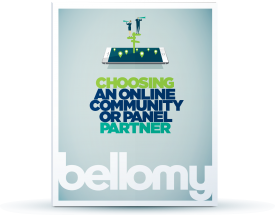How to build an online community: Recruiting the right research participants
 Sourcing sample to reflect a particular customer base and achieving the right mix of a target audience in any given study are tried-and-true challenges that customer insights teams face. That’s why so many brands have turned to establishing their own online research communities, affording fast access to qualified participants who are ready to provide feedback.
Sourcing sample to reflect a particular customer base and achieving the right mix of a target audience in any given study are tried-and-true challenges that customer insights teams face. That’s why so many brands have turned to establishing their own online research communities, affording fast access to qualified participants who are ready to provide feedback.
While the effort can seem daunting, here are a few pointers for getting started with successfully building an online research community.
Align with stakeholders on business and research objectives
First things first: Have internal conversations among the departments that may have an interest in hearing from customers. Given that insights from target customers can have widespread reach throughout the company, understanding and aligning on the research community’s purpose and anticipated research needs is paramount to optimizing its potential. Some important questions to consider include:
- What initiatives are taking place throughout the company? There may be opportunities to support or enhance those efforts with research. Finding out what other departments might be interested in learning will help inform whether the company needs a dedicated research community (versus sourcing participants on an ad hoc basis), that you’ll be able to engage with members at a healthy cadence, and that it’s a worthwhile investment.
- Who do you need to hear from? You’ll want to ensure that your research community reflects your target audience. With a research community specific to your brand, you’ll want to think about demographics, segments, personas, and what quotas you need to hit to get an accurate representation.
- How will you incentivize research community members to participate? Incentives cannot be an afterthought. As much as people want to believe consumers will be self-motivated to tell you what they think, research communities that incentivize appropriately have much higher participation rates.
Aligning on some of these foundational roots will make the time and effort you put into recruiting fruitful and worthwhile.
Invitations to participate in a research community should be strategic
It's important to consider your outreach strategy before beginning recruitment. The last thing you want to do is invest effort into a ton of messaging that doesn’t resonate and is a waste of time (for both you and your targeted community members).
In most cases, email is most efficient—especially when trying to recruit established customers. But it's important that the email comes from a trusted sender. Recruitment emails from the brand or company itself have higher open and engagement rates than emails from a third-party, as customers will recognize and trust the source.
Data security and sensitivity is also something to consider—when companies email from their own domain, it alleviates the need to share thousands (and hundreds of thousands) of customer records. While there are secure methods of transferring such data, a better approach is for the company to email their customers from a trusted domain to see who is interested in joining their community. A third-party that specializes in managing online communities can nurture the relationships that follow. Such partners can offer guidance on the recruitment email strategy and content—you just have to hit, “Send.”
Make participating in a research community inviting and compelling
Connotations with “research” aren’t always the most exciting for consumers, but the opportunity to share thoughts on something consumers are passionate about, and get rewarded for it, can be much more enticing. Here are some tips for crafting invites that turn into sign-ups:
- Keep the content of the invitation short and compelling with only the most important information—why they should join and what they’ll get out of it.
- Include multiple opportunities for the recipient to click to join (and any deadline they have to do so).
- Run A/B tests to determine which subject lines are most successful before sending to larger audiences.
- Perform spam tests to increase deliverability. Terms like “gift card” and “reward” are examples that could land your email in junk inboxes.
Consider what other sources can help with recruiting research participants
Though email has the most successful recruitment rate, there are other ways to build online research communities—especially when targeting current customers. Take advantage of existing touchpoints, such as plugs at the end of communication customers already receive, website pop-ups, or QR codes on bills and other messaging. Social media is another excellent choice for casting a wide net—just be sure to target individuals who will meet the research community criteria.
Getting started with an online research community
If ongoing research with customers is a priority, investing in an online research community is a great consideration for saving time and money. Contact one of our community research specialists to determine whether establishing a pool of qualified customers in an online community is right for your brand’s goals and long-term needs.
